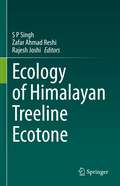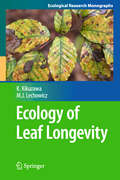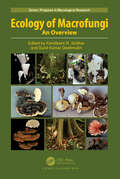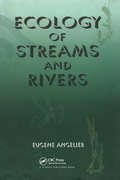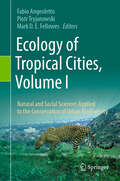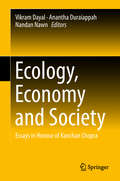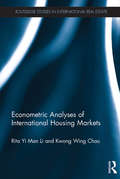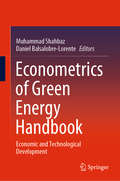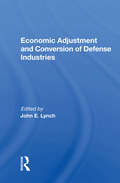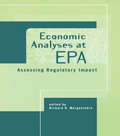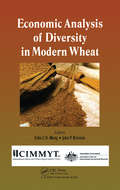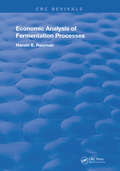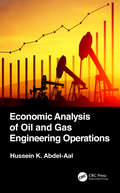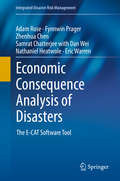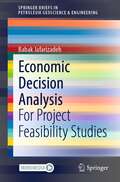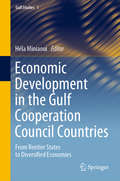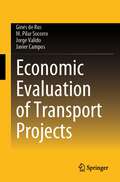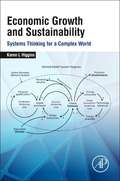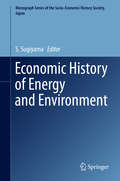- Table View
- List View
Ecology of Angola: Terrestrial Biomes and Ecoregions
by Brian John HuntleyThis open access book richly illustrates the first, and comprehensive, account of the country’s biomes and ecoregions, the driving forces that account for their diversity and vulnerability, and the ecological principles that provide an understanding of the patterns and processes that have shaped landscapes, ecoregions, and ecosystems. Angola encompasses the greatest diversity of terrestrial biomes and is the second richest in terms of ecoregions, of any African country. Yet its biodiversity and the structure and functioning of its ecosystems are largely undocumented. The author draws on personal field observations from over 50 years of involvement in ecological and conservation studies in Angola and across Southern Africa. The vast recent literature published by researchers in neighboring, better resourced countries provides depth to the accounts of ecological principles and processes relevant to Angola and thus contributing to the understanding and sustainable management of its natural resources.
Ecology of Central European Non-Forest Vegetation: Volume Ii
by Christoph Leuschner Heinz EllenbergThis handbook in two volumes synthesises our knowledge about the ecology of Central Europe's plant cover with its 7000-yr history of human impact, covering Germany, Poland, the Netherlands, Belgium, Luxembourg, Switzerland, Austria, Czech Republic and Slovakia. Based on a thorough literature review with 5500 cited references and nearly 1000 figures and tables, the two books review in 26 chapters all major natural and man-made vegetation types with their climatic and edaphic influences, the structure and dynamics of their communities, the ecophysiology of important plant species, and key aspects of ecosystem functioning. Volume I deals with forests and scrub vegetation and analyses the ecology of Central Europe's tree flora, whilst Volume II is dedicated to the non-forest vegetation covering mires, grasslands, heaths, alpine habitats and urban vegetation. The consequences of over-use, pollution and recent climate change over the last century are explored and conservation issues addressed.
Ecology of Himalayan Treeline Ecotone
by Rajesh Joshi S P Singh Zafar Ahmad ReshiThis book brings together comprehensive multi-disciplinary knowledge on diverse aspects of the Himalayan treeline ecotone which is considered one of the most sensitive ecosystems to climate change. The contents of this book are based on the results of extensive research and provide a holistic understanding of the treeline ecotone in Himalaya. The book will serve as an important reference manual and a textbook on treeline ecology. The book is unique in the sense that it provides an engaging account of almost all the aspects of the treeline ecotone, such as taxonomic, functional and phylogenetic species diversity, temperature lapse rates, tree phenology, water relations, and stress physiology, tree ring width chronology, and climate relationships and the role of treeline ecotone in human sustenance in the Indian Himalayan region The treelines in the Himalaya, being the highest in the Northern Hemisphere (up to 4900 m), are among the least investigated systems and hence this book is timely and fills all-important knowledge gaps vis-à-vis treeline shifts, physiognomic, structural, and functional changes in mountain landscapes and ecosystems, particularly under the changing climate This book, for the first time, summarizes evidence-based knowledge about various aspects of treeline ecotone in Himalaya that was largely generated through a well-coordinated a team science approach. The book will be of interest to ecologists, climatologists, dendrochronologists, foresters, plant physiologists and resource managers and policy planners for a better understanding of the organization and dynamics of this fragile ecosystem in relation to climate change and other anthropogenic stresses that are rampant in the Himalaya. The book lays a solid foundation for further investigation of the ecology and dynamics of the treeline ecotone in the Himalayas and provides a rationale for pursuing a team science approach for macroecological investigations.
Ecology of Leaf Longevity
by Kihachiro Kikuzawa Martin J. LechowiczLeaf longevity is a fundamental process underlying patterns of variation in foliar phenology and determining the distinction between deciduous and evergreen plant species. Variation in leaf longevity is associated with a wide array of differences in the physiology, anatomy, morphology and ecology of plants. This book brings together for the first time information scattered widely in the botanical literature to provide a clear and comprehensive introduction to the nature and significance of variation in leaf longevity. It traces the development of ideas about leaf longevity from the earliest descriptive studies to contemporary theory of leaf longevity as a key element in the function of leaves as photosynthetic organs. An understanding of variation in leaf longevity reveals much about the nature of adaptation at the whole plant level and provides fundamental insights into the basis of variation in plant productivity at the ecosystem level. The analysis of leaf longevity also provides a process-based perspective on phenological shifts associated with the changing climate. Readers will find this an informative synthesis summarizing and illustrating different views in a readily accessible narrative that draws attention to a central but too often unappreciated aspect of plant biology. The nature and causes of seasonal patterns in the birth and death of individual plant leaves are essential to the understanding of the health of plant communities, biomes, and consequently our planet.
Ecology of Macrofungi: An Overview (Progress in Mycological Research)
by Sunil Kumar Deshmukh Kandikere R. SridharMacrofungi have significant importance in human health, particularly in nutrition, medicine, pharmaceuticals, agriculture and industries. They occupy a variety of ecosystems such as terrestrial (agricultural lands, forests and deserts), freshwater (bogs and marshes) and maritime (mangroves and coastal sand dunes) habitats. Their ecosystem services like nutrition (humans and animals), medicinal pursuits (antibiotics and pharmaceuticals) and bioremediation (degradation of xenobiotics and insect control) potential are dependent on their diversity and ecological conditions. Macrofungal ecology serves as the basis for nutraceutical values, agricultural benefits, plant productivity, environmental protection and industrially valued biocomposites. This book focuses on various aspects of macrofungal distribution in diverse habitats, participation in organic matter decomposition, ectomycorrhizal associations and participation in biogeochemical cycles. This book reviews the current developments in macrofungal ecology in different habitats and their benefits. Due to the topics dealt with on macrofungal diversity, distribution, dynamics, lifestyles, ecosystem or substrate preferences and ecosystem services, this book is valuable to mycologists, botanists, zoologists, ecologists, foresters, geneticists, agronomists and field biologists.
Ecology of Streams and Rivers
by Eugene AngelierAiming to describe the role of dominant ecological factors and of human activities on the organisms of running water and the functioning of the ecosystem, this work covers the few European water courses that are well known in ecological studies.
Ecology of Threatened Semi-Arid Wetlands
by David G. Angeler Salvador Sánchez-CarrilloPlaying a critical role in both influencing climate change and mitigating its impacts, the world's diverse wetlands have become one of the world's most threatened ecosystems as unsustainable land-use practices coupled with irrational use of water have already resulted in large-scale wetlands loss and degradation. To develop sound management and conservation schemes to assure wetlands sustainability in the long term requires long-term understanding of wetlands ecology. Yet until now, long-term interdisciplinary research into these systems has been limited to only a few systems from tropical or temperate climates (such as the Florida Everglades, and Czech biosphere reserve). This new book adds to the existing wetlands literature, providing a unique reference in basic and applied Mediterranean wetland ecology, based on results from long-term interdisciplinary research at the RAMSAR and UNESCO Biosphere site, of Las Tablas de Daimiel, Spain. Dating back to the early 1990s the research highlights changes in the biotic and abiotic environment in response to cumulative anthropogenic stressors, and provide guidance on applying this understand to sound management and conservation. With particular relevance to researchers dealing with semi-arid wetlands in the Mediterranean and elsewhere, as well as to resource managers, the book discusses the complexity of the interacting abiotic and biotic environment across different spatial and temporal scales and across various levels of biological hierarchy is highlighted, and reveals how management based on poor knowledge causes more damage than repair. The book will be of interest to researchers interested in freshwater ecology, hydrobotany, hydrology, geology, biogeochemistry, landscape ecology and environmental management.
Ecology of Tropical Cities, Volume I: Natural and Social Sciences Applied to the Conservation of Urban Biodiversity
by Piotr Tryjanowski Fabio Angeoletto Mark D. E. FellowesThis contributed volume addresses the global scale of urbanization and its impacts on biodiversity. By adding human capital, cities are incubators for new ideas and technologies, creating the possibility for socially and environmentally sensitive growth, but this is rarely seen. Urban ecology, an essential field that supports planning based on environmental perspectives, is a new science in tropical countries. This book discusses the social inequity embedded in tropical cities and explores how this inequity also materializes in biodiversity, with poor neighborhoods of tropical cities lacking sufficient access to green space, and therefore reduced access to the benefits of nature, and poor support for biodiversity. With the current biodiversity crisis, the traditional approach to protecting pristine areas is insufficient. The chapters in this volume illustrate how tropical cities can act as spaces for biological conservation. Ecological literacy can help cities reconcile the needs of both people and of nature. This book compiles studies by experts from more than 100 institutions and 29 countries on the ecology and biodiversity of tropical cities at multiple scales and applies their studies to urban planning and management. The audience for this book includes researchers, students, and professionals working on environmental, social, economic, cultural, political, architectural, and development projects in urban areas, offering a deep and timely discussion of their influence on the fauna and flora of tropical cities.
Ecology, Conservation, and Restoration of Chilika Lagoon, India (Wetlands: Ecology, Conservation and Management #6)
by C. Max Finlayson Gurdeep Rastogi Deepak R. Mishra Ajit K. PattnaikThis book chronicles the decades-long work of studying, analyzing, and reversing the environmental pressures that threatened India’s Chilika Lagoon, the largest brackish-water lagoon in the region, and the second largest in the world. Designated as one of India’s first Ramsar Sites in 1981, Chilika Lagoon continued to degrade for a decade longer. Then, the Chilika Development Authority (CDA) was established to gather information and devise a restoration plan that benefits the ecosystems of the lagoon, with sensitivity to the needs and livelihoods of local communities. Expert contributors detail the work of analysis, planning and implementation, including extensive coverage of such topics as: Devising a plan for implementing Ramsar wise use guidelines Sedimentologic, chemical, and isotopic impacts Hydrodynamics and salinity Runoff and sediment in watersheds of the Lagoon's Western Catchment Long-term analysis of water quality and continued water quality monitoring Bio-optical models for cyclone impact assessment Studies of geomorphology, land use, and sedimentary environments Spatiotemporal assessment of phytoplankton communities Creation of a post-restoration scenario for fish and fisheries Assessing status of waterbirds, species diversity and migration patterns The result was a major hydrological intervention to re-establish hydrological and salinity regimes, biodiversity, and fish catches, and help protect the livelihood of lagoon-dependent communities. The story of the rehabilitation and management of Chilika Lagoon demonstrates that it is possible to halt and reverse the encroachment and degradation of wetlands, to restore biodiversity and to provide benefits for large numbers of people. Ecology, Conservation, and Restoration of Chilika Lagoon goes beyond scientific research articles to explore institutional and governance issues, political ecology, and the Ramsar Convention’s guidelines for ecosystem restoration. The book will benefit researchers, wetland managers, government policy makers and more general readers concerned with restoration and conservation of wetlands around the planet.
Ecology, Economy and Society: Essays in Honour of Kanchan Chopra
by Vikram Dayal Anantha Duraiappah Nandan NawnThis book deals with not just complex linkages, interactions and exchanges that form the relationship between the economic activities, human society and the ecosystems, but also the influences and impacts that each causes on the other. In recent times, this ecology–economy–society interface has received unprecedented attention within the broader environment–development discourse. The volume is in honour of Kanchan Chopra, one of the pioneers of research in these areas in India. She has recently been awarded the coveted Kenneth Boulding Award by the International Society for Ecological Economics (ISEE) and is the first Asian to receive it. The four sub-themes of the book reflect some of the important areas in the environment–development discourse — sustainability of development, institutions and environmental governance, environment and well-being, and ecosystem and conservation. Within each of the sub-themes, the policy and the practice as well as the macro and micro aspects are addressed. With contributions mainly from ecological economists and ecologists, the book’s approach is interdisciplinary, both in spirit and content, reflecting the honoree's work, which went not just beyond the mainstream ideology of economics, but also the way she listened to ideas from disciplines like ecology and sociology. The volume also includes two reflective essays on academic life and works of Kanchan Chopra. The book is a valuable resource for students, teachers, researchers, practitioners and policy makers in the areas of development economics, ecological economics, environmental economics and related disciplines such as conservation, development, ecology, economics, environment, governance, health, sociology and public policy.
Ecology, Soils, and the Left
by Salvatore Engel-Di MauroSoil degradation is real and global, even if the evidence is not so easy to glean. Degradation poses comparable risks to greenhouse gas emissions, deforestation, and nonhuman animal extinctions. Few have noticed soil degradation as the problem it has become, except most indigenous peoples in their struggles for survival.
Econometric Analyses of International Housing Markets (Routledge Studies in International Real Estate)
by Rita Yi Man Li Kwong Wing ChauThis book explores how econometric modelling can be used to provide valuable insight into international housing markets. Initially describing the role of econometrics modelling in real estate market research and how it has developed in recent years, the book goes on to compare and contrast the impact of various macroeconomic factors on developed and developing housing markets. Explaining the similarities and differences in the impact of financial crises on housing markets around the world, the author's econometric analysis of housing markets across the world provides a broad and nuanced perspective on the impact of both international financial markets and local macro economy on housing markets. With discussion of countries such as China, Germany, UK, US and South Africa, the lessons learned will be of interest to scholars of Real Estate economics around the world.
Econometrics of Green Energy Handbook: Economic and Technological Development
by Muhammad Shahbaz Daniel Balsalobre-LorenteThis book gathers cutting-edge studies on the relationship between energy innovations, economic growth, environmental regulation, promotion of renewable energy use, and climate change. Building on the research discussed in the editor’s previous book Decarbonization and Energy Technology in the Era of Globalization, it discusses recent developments such as the impacts of globalization and energy efficiency on economic growth and environmental quality. It also explores the ways in which globalization has benefited green energy development, e.g. the expansion of new technologies and cleaner machinery, as well as the problems it has caused. Written by respected experts, the respective contributions address topics including econometric modelling of the behaviour of and dynamics between economic growth and environmental quality, aspects of energy production and consumption, oil prices, economic growth, trade openness, environmental quality, regulatory measures, and innovations in the energy sector. Providing a comprehensive overview of the latest research, the book offers a valuable reference guide for researchers, policymakers, practitioners and students in the fields of renewable energy development and economics.
Economic Adjustment And Conversion Of Defense Industries
by John E. LynchDefense plant cutbacks and military base closures have affected hundreds of U.S. communities during the past twenty-five years. Tracing the recovery of four communities after large defense plant cutbacks and of one hundred communities after military base closures, the contributors analyze the transition from the production of military to civilian goods. The contributors examine the market potential of reusing defense industrial plants to produce civilian products within the one- to two-year period called for by economic conversion proponents, showing that the complex process needed to develop, test, and market an entirely new product requires a minimum of five years. They also review the wide range of economic development techniques available at the state and local level, conversion approaches in Western Europe, programs for displaced workers, and reasons why the economic conversion approach has failed to attract public support in the United States. The case studies are used to formulate an integrated, composite approach for coping with plant closures and major employment dislocations. Stressing the in portance of community-based economic adjustment activities, this book will be valuable to all concerned with mitigating the effects of military and civilian plant closures.
Economic Analyses at EPA: Assessing Regulatory Impact
by Richard D. MorgensternFor years, the Environmental Protection Agency has been conducting programmatic 'economic analyses,' also known as Regulatory Impact Analyses (RIAs), to assess the economic effects of its regulatory efforts. This important volume explains the purpose of these analyses, along with their design, execution, conclusions, and their ultimate impact on environmental rules. Richard Morgenstern, formerly director of EPA‘s Office of Policy Analysis, has assembled twelve original case studies of RIAs performed over the past decade on matters such as lead in gasoline, ozone depletion, asbestos, clean drinking water, and sewage management. The contributors, most of whom actually worked on these RIAs, provide detailed examination of why and how they were performed. The case studies critique the nature, amount, and quality of data used by the EPA in their benefit-cost and cost-effectiveness analyses as well as the use (or abuse) of the results in final decisionmaking. The authors illustrate how the analyses take into account difficult issues such as discounting, risk, nonmonetized benefits and costs, and equity. Morgenstern provides the necessary historical context and the legal framework for requiring and conducting EAs. He describes new procedures outlined by the Clinton administration and synthesizes the case studies into thoughtful cross-cutting conclusions, drawing important lessons that will improve future analyses.
Economic Analysis for Property and Business
by Marcus WarrenMarcus Warren's book provides a broad coverage of economic theory, analysis and policy relevant to most undergraduate students studying economics as part of their degree. Specifically it is designed for students studying for property and business related courses and is a vital purchase for all first year students and some second year students involved in these disciplines. It is also relevant for accountancy, business and marketing students studying economics as one or two of their modules. The main feature of this book is the inclusion of an application for students on property surveying courses, building surveying courses and rural land management students as well as some pure business examples for the business students. These applications will cover the main markets for this book at the end of each theory section. The text is clear, concise and includes real life examples and case studies to back up the theory presented. It is global in its appeal, especially relevant for the UK, Europe and the Commonwealth.
Economic Analysis of Diversity in Modern Wheat
by Erika C.H. Meng John P. BrennanScientific breeding in the twentieth century greatly accelerated wheat`s evolution, producing high-yielding varieties that helped avoid famine in many developing countries. Emerging scientific tools hold promise for identifying and tapping new, useful genetic diversity within wheat`s primary and secondary gene pools and, through genetic engineering, beyond.The book describes generally how policies affect wheat genetic diversity; it looks at historical changes in wheat genetic diversity, as policy and priorities have evolved; it identifies factors that explain changes and differences in spatial diversity; and finally, it analyzes the productivity impacts of changes in diversity. Chapters define various types of crop genetic diversity and ways to measure them, framing the definitions and metrics in the contexts for which they are most relevant.
Economic Analysis of Fermentation Processes (Routledge Revivals)
by Harold B. ReismanPublished in 1988: It is the purpose of this book to outline and detail the many steps which are involved in bringing a fermentation product to market.
Economic Analysis of Oil and Gas Engineering Operations
by Hussein K. Abdel-AalEngineers seek solutions to problems, and the economic viability of each potential solution is normally considered along with the technical merits. This is typically true for the petroleum sector, which includes the global processes of exploration, production, refining, and transportation. Decisions on an investment in any oil or gas field development are made on the basis of its value, which is judged by a combination of a number of economic indicators. Economic Analysis of Oil and Gas Engineering Operations focuses on economic treatment of petroleum engineering operations and serves as a helpful resource for making practical and profitable decisions in oil and gas field development. Reflects major changes over the past decade or so in the oil and gas industry Provides thorough coverage of the use of economic analysis techniques in decision-making in petroleum-related projects Features real-world cases and applications of economic analysis of various engineering problems encountered in petroleum operations Includes principles applicable to other engineering disciplines This work will be of value to practicing engineers and industry professionals, managers, and executives working in the petroleum industry who have the responsibility of planning and decision-making, as well as advanced students in petroleum and chemical engineering studying engineering economics, petroleum economics and policy, project evaluation, and plant design.
Economic Consequence Analysis of Disasters
by Dan Wei Adam Rose Fynnwin Prager Zhenhua Chen Samrat Chatterjee Nathaniel Heatwole Eric WarrenThis study develops a methodology for rapidly obtaining approximate estimates of the economic consequences from numerous natural, man-made and technological threats. This software tool is intended for use by various decision makers and analysts to obtain estimates rapidly. It is programmed in Excel and Visual Basic for Applications (VBA) to facilitate its use. This tool is called E-CAT (Economic Consequence Analysis Tool) and accounts for the cumulative direct and indirect impacts (including resilience and behavioral factors that significantly affect base estimates) on the U. S. economy. E-CAT is intended to be a major step toward advancing the current state of economic consequence analysis (ECA) and also contributing to and developing interest in further research into complex but rapid turnaround approaches. The essence of the methodology involves running numerous simulations in a computable general equilibrium (CGE) model for each threat, yielding synthetic data for the estimation of a single regression equation based on the identification of key explanatory variables (threat characteristics and background conditions). This transforms the results of a complex model, which is beyond the reach of most users, into a "reduced form" model that is readily comprehensible. Functionality has been built into E-CAT so that its users can switch various consequence categories on and off in order to create customized profiles of economic consequences of numerous risk events. E-CAT incorporates uncertainty on both the input and output side in the course of the analysis.
Economic Decision Analysis: For Project Feasibility Studies (SpringerBriefs in Petroleum Geoscience & Engineering)
by Babak JafarizadehThis book discusses the art and science of economic decision making. It combines logical thinking with analytics, economics, and finance to draw decision insights for the upstream petroleum projects. The book offers useful analysis skills for practitioners in industry, including analysts, engineers, and managers. In addition, advanced undergraduate and graduate students in petroleum engineering, applied petroleum geoscience, industrial engineering, and energy business would benefit from the discussions in this book.
Economic Development in the Gulf Cooperation Council Countries: From Rentier States to Diversified Economies (Gulf Studies #1)
by Héla MiniaouiThis book delves into the economic development of the six Gulf Cooperation Council (GCC) countries. Since the 1960s, the GCC states have harnessed their potential to exploit the wealth accrued from the oil boom to build their infrastructure and grow their economies. However, the high level of dependency on oil as the primary source feeding their output made their economies volatile and vulnerable to fluctuations in the global oil prices. Moreover, the plunge in oil prices and the threat of depletion of this natural resource pose serious challenges to the GCC countries. Consequently, the GCC governments have realized the importance of diversifying their economies following the need to move away from reliance on hydrocarbon.This book contributes to the theoretical literature by enriching the debate on the transition of the GCC countries from rentier states to diversified economies. It helps students and scholars understand this transformation with an expansive comprehension of the contemporary challenges facing the region, as well as outlining prospects for the future.
Economic Evaluation of Transport Projects
by Javier Campos Ginés de Rus M. Pilar Socorro Jorge ValidoThis book is a guide to the economic evaluation of transport policies and investment projects through cost-benefit analysis (CBA). It covers the CBA of transportation projects and policies, and introduces the fundamental concepts of CBA before considering their application in real-world settings.A distinct focus of the book is on the practical applications of CBA. It includes real-world examples of CBA, such as high-speed rail investment and the subsidization of air transport, which illustrate the importance of using a rigorous analytical framework to evaluate transport projects and policies.The primary objective of this book is to present a basic model for the evaluation of transport projects and policies, with explicit assumptions and practical evaluation rules derived from it. The rules and measurement criteria derived from this model are applied to the examples mentioned above.Overall, this book is an excellent resource for students, practitioners, and policymakers involved in transport economics and evaluation, as it provides a comprehensive understanding of the principles and applications of CBA in the transport sector.
Economic Growth And Sustainability: Systems Thinking For A Complex World
by Karen HigginsHow to sustain our world for future generations has perplexed us for centuries. We have reached a crossroads: we may choose the rocky path of responsibility or continue on the paved road of excess that promises hardship for our progeny. Independent efforts to resolve isolated issues are inadequate. Different from these efforts and from other books on the topic, this book uses systems thinking to understand the dominant forces that are shaping our hope for sustainability. It first describes a mental model - the bubble that holds our beliefs - that emerges from preponderant world views and explains current global trends. The model emphasizes economic growth and drives behavior toward short-term and self-motivated outcomes that thwart sustainability. The book then weaves statistical trends into a system diagram and shows how the economic, environmental, and societal contributors of sustainability interact. From this holistic perspective, it finds leverage points where actions can be most effective and combines eight areas of intervention into an integrated plan. By emphasizing both individual and collective actions, it addresses the conundrum of how to blend human nature with sustainability. Finally, it identifies primary three lessons we can learn by applying systems thinking to sustainability. Its metaphor-rich and accessible style makes the complex topic approachable and allows the reader to appreciate the intricate balance required to sustain life on Earth.
Economic History of Energy and Environment
by S. SugiyamaThis book is the first volume of a monograph series published by the Socio-Economic History Society, Japan. The purpose of the series is to make works by Japanese scholars accessible to a wider readership and to increase the knowledge of scholars in this field, particularly in relation to Asia. This volume includes four chapters on energy and the environment of Japan, China and Britain and four short book reviews on recent academic works published in Japanese and English. The four chapters cover the following topics: the relationship between deforestation and the development of the silk reeling industry in a district of Nagano Prefecture (central Japan) from the 1870s to the 1900s and the subsequent shift from firewood to coal; the importance of timber supplies for the development of industry as illustrated by a case study on the supply of timber for use as rail sleepers in the Japanese national railway network during the prewar period; a methodological survey of the history of ecology and the environment in China; and an analysis of the British Smoke Nuisance Abatement Act of 1821 as a measure that incorporated the interests of politicians, landlords and industrialists.


